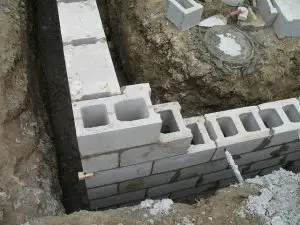Concrete block foundations are built using concrete blocks that are typically 8 inches by 16 inches. Although they do come in various sizes, this is the size that is most commonly used for foundations. The concrete blocks rest on a concrete footing that has been poured deep and wide enough to accommodate the load of the blocks and the building.
Advantages and Disadvantages of Concrete Block Foundations
The blocks are placed just like a bricks, in a pattern that overlaps to help interlock them together. This ensures that the foundation is strong and stable. Since the blocks are hollow inside, re-bar is placed inside to connect the blocks to the footing for addition stability. Concrete block foundations have their advantages, but they also have their disadvantages. You might also be interested in our article on building a house foundation.

Advantages of Concrete Block foundation
Concrete block foundations have some advantages as below.
- Wooden forms are not needed. With a poured foundation there are forms that have to be pieced together and then properly secured before the concrete can be mixed and poured.
- Blocks are light and easy to install. Any person who has masonry experience can install a concrete block foundation.
- The blocks are strong and well insulated. When the re-bar is used, it adds strength to the structure and the filled blocks insulate the building well.
- They are well suited to construction in seismic areas. They are a versatile building material.

Disadvantages
There are also some disadvantages of concrete block foundations. The major ones are listed below.
- People take short-cuts and not fill every block with mortar. By taking this short-cut, the integrity of the foundation is compromised and the structure is relatively weak.
- The mortar that is used to adhere the blocks together will crumble and disintegrate over time. Leaks are a direct result and must be dealt with as soon as they are detected.
- High maintenance costs for block foundations. Mortar must constantly be monitored and blocks must be sealed every so often to ensure that no leaks occur.
- Concrete blocks can be expensive. Traditional building supplies are less expensive than purchasing enough blocks for a full foundation. Concrete blocks are typically two to three times more expensive than wood construction.
- Concrete blocks are not pretty. Generally laid out in the same pattern as brick, concrete blocks are viewed as cold and utilitarian. Concrete is not easily covered and is difficult to visually enhance. Some people stucco the blocks to hide the ugliness. Others simply paint the blocks and leave them exposed for people to see. Extra landscaping is also used to hide block foundations.
- Waterproofing is a must. The blocks are porous and the mortar is not leak proof. Therefore a commercial grade waterproof sealer is required to ensure that the foundation does not leak.
Concrete block foundations are not as popular as they once were. This is partly because of the cost and partly because of the aesthetics of the foundation. In today’s society, people expect beauty and functionality to go hand in hand. A block foundation is not beautiful and it has higher maintenance than a poured foundation. The disadvantages overshadow the advantages and in time, this type of foundation will become obsolete.

